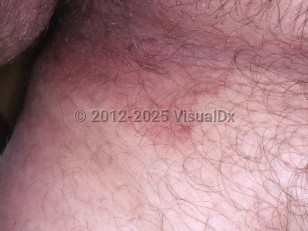Tinea cruris - Anogenital in
See also in: Cellulitis DDxAlerts and Notices
Important News & Links
Synopsis

Tinea cruris (jock itch) is a superficial fungal infection of the skin of the inguinal creases, most commonly caused by Trichophyton rubrum. Other causative pathogens include Epidermophyton floccosum, Trichophyton mentagrophytes, Trichophyton indotineae, and Trichophyton mentagrophytes genotype type VII (TMVII).
Tinea cruris manifests as symmetric or asymmetric erythematous annular plaques that extend from the inguinal creases to the inner upper thighs. Plaques may extend onto the scrotum as well (see tinea pubogenitalis). Concomitant tinea pedis is often present and, if so, is likely the source of the infection.
Tinea cruris is frequently pruritic. It is more common in adolescent and postpubertal males. People at higher risk include those who have diabetes mellitus, are obese, recently visited a tropical climate, wear tight-fitting or wet clothes (including bathing suits) for extended periods, share clothing with others, or participate in sports. Sexual transmission is the leading cause of TMVII. Reports of TMVII include travelers who had contact with sex workers in Southeast Asia and cases among men who have sex with men (MSM), in particular in France, Germany, Italy, the United States, and probable cases in Austria. Cases of sexual transmission of T indotineae have also been reported.
In the immunocompromised patient, pruritus may be absent. There is an increased risk of all dermatophyte infections (tinea pedis, cruris, corporis, and faciei as well as Majocchi granuloma) in immunocompromised individuals.
Tinea cruris manifests as symmetric or asymmetric erythematous annular plaques that extend from the inguinal creases to the inner upper thighs. Plaques may extend onto the scrotum as well (see tinea pubogenitalis). Concomitant tinea pedis is often present and, if so, is likely the source of the infection.
Tinea cruris is frequently pruritic. It is more common in adolescent and postpubertal males. People at higher risk include those who have diabetes mellitus, are obese, recently visited a tropical climate, wear tight-fitting or wet clothes (including bathing suits) for extended periods, share clothing with others, or participate in sports. Sexual transmission is the leading cause of TMVII. Reports of TMVII include travelers who had contact with sex workers in Southeast Asia and cases among men who have sex with men (MSM), in particular in France, Germany, Italy, the United States, and probable cases in Austria. Cases of sexual transmission of T indotineae have also been reported.
In the immunocompromised patient, pruritus may be absent. There is an increased risk of all dermatophyte infections (tinea pedis, cruris, corporis, and faciei as well as Majocchi granuloma) in immunocompromised individuals.
Codes
ICD10CM:
B35.6 – Tinea cruris
SNOMEDCT:
399029005 – Tinea cruris
B35.6 – Tinea cruris
SNOMEDCT:
399029005 – Tinea cruris
Look For
Subscription Required
Diagnostic Pearls
Subscription Required
Differential Diagnosis & Pitfalls

To perform a comparison, select diagnoses from the classic differential
Subscription Required
Best Tests
Subscription Required
Management Pearls
Subscription Required
Therapy
Subscription Required
References
Subscription Required
Last Reviewed:09/18/2025
Last Updated:09/18/2025
Last Updated:09/18/2025
 Patient Information for Tinea cruris - Anogenital in
Patient Information for Tinea cruris - Anogenital in
Premium Feature
VisualDx Patient Handouts
Available in the Elite package
- Improve treatment compliance
- Reduce after-hours questions
- Increase patient engagement and satisfaction
- Written in clear, easy-to-understand language. No confusing jargon.
- Available in English and Spanish
- Print out or email directly to your patient
Upgrade Today

Tinea cruris - Anogenital in
See also in: Cellulitis DDx
